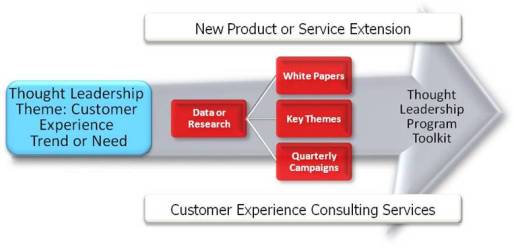Let’s resume the conversation about how to use customer experience research for effective thought leadership marketing campaigns. In Part 1 we examined some case studies from B2B companies such as IBM and Accenture. Now let’s take a look at how to build a successful thought leadership program.
The first and most critical step is to pick a compelling thought leadership theme that will resonate with your target markets. Because customers have so much more choice
and power in today’s market, you may want to choose an aspect of customer experience
in your industry that is changing or needs to. For example, my last company’s primary business is call center operations. Because most service contracts are negotiated on standard service level agreements (SLA’s), such as average speed of answer (ASA) and average handle time (AHT), calls become commodities measured by throughput. Customer experience easily becomes ancillary. That may have been the way of the world before, but now customers can “bite back” by broadcasting their bad call center experiences on social media – thereby damaging the client company’s brand and market share. The time has come for other customer-based metrics to replace standard
SLA’s. So after joining the company in 2007, I began transforming their brand proposition from low-price leader to customer experience thought leader. Your mission,
should you choose to accept it, is to find a similar customer experience trend or need to “own”. Your theme should not only be insightful, but should identify a problem that your company can solve or a new direction that your company is trailblazing.
Next, you need data. In order for your corporate thought leadership to be valuable to target markets, it must be built upon credible, eye-opening information that
isn’t widely available. It’s a “build or buy” situation. You may want to build if you have sizeable customer databases from which to draw survey samples and access to internal resources that can assist with data collection or analysis. I decided to partner with an internal analytics group to build fresh large-scale primary research about customer experiences with call centers. But you may not need to gather new data – many large companies have enormous data warehouses that can be mined.
If you want to buy, there are dozens if not hundreds of analyst firms out there who will help you conduct research, analyze it for key themes, and write white papers. With a good data-packed white paper to start from, you can build an enormous range of effective thought leadership marketing materials. The most credible sources – such as Gartner and Forrester – may let you help structure the project, but allow less control over interpretations and outcomes. Less credible firms will let you structure, interpret and re-write because they have less reputation on the line. Expect to pay upwards of $25k per white paper depending on the logo on the cover. If that’s too rich, look for market research vendors who can collect the data, then use internal resources for analysis and interpretation.
With theme, data and white paper in hand, you are ready to launch your thought leadership campaign. But before you invest heavily, make sure your executive committee is on board with the thought leadership theme. If they don’t embrace the new direction,
don’t expect to lead a campaign that will change the world. In my experience, it helps if you “digest” the research’s key findings into a few key themes and quarterly campaigns, then show how those can lead to sales conversations. You can even map out product extensions, including consulting services. Be aware, though, that your company may not be ready to “go there”. I learned this the hard way, discovering that my company was happy to talk about customer experience, but not ready to recommend new SLA’s. But even if your thought leadership program is initially lipstick on a pig, it can still be extremely effective for brand building and demand generation. With perseverance, it may become a new way of thinking that slowly turns the ship.
Next time we’ll discuss the thought leadership program toolkit. Stay tuned to learn about the techniques and channels you can use to deploy your customer experience program internally and externally for maximum impact.



